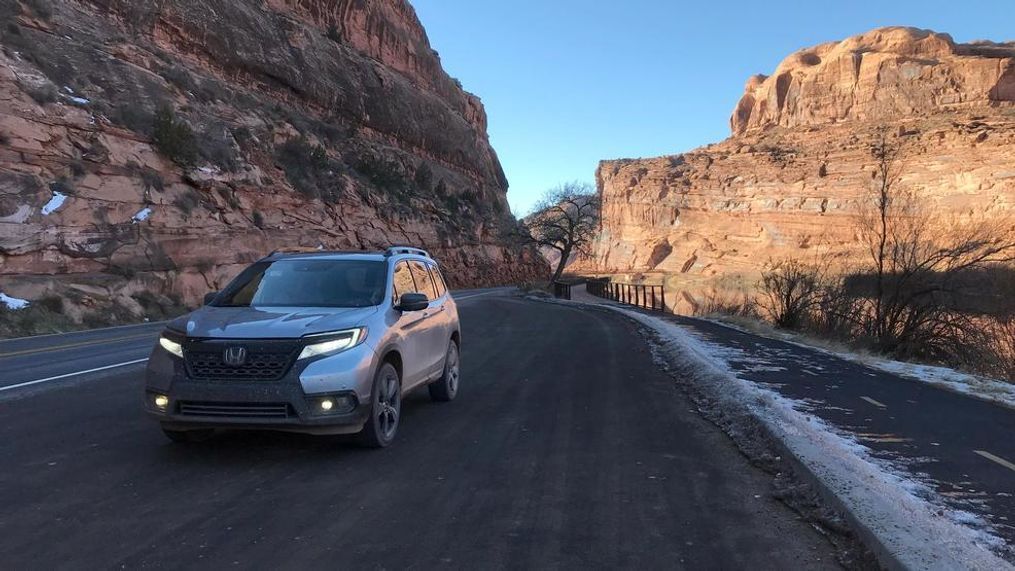5 things to know about the 2019 Honda Passport
Honda fills a gap in its lineup with the 2019 Passport. Slotted between the C-RV and the Pilot, this two-row SUV adds more capability than its little brother and more sport than its bigger one.
Here are some other things you should know about the all-new Passport.
Safety is standard
Honda has done what most of its competitors have not: It has made its safety suite, Honda Sensing, standard across all trims of the Passport. This includes features such as automatic emergency braking, lane keep assist, lane departure warning and adaptive cruise control.
In initial testing, the NHTSA hasn’t given the 2019 Passport an overall rating yet, but it gets 4 stars in a frontal crash and 5 stars in a side crash.
The Insurance Institute for Highway Safety gives the Passport mostly “Good” ratings in its crash testing, but Passport misses getting a “Top Safety Pick” rating because of “Poor” headlights. In the analysis, IIHS said the Passport headlights create excessive glare and note that they are not curve adapted.
Not sure what safety ratings, mean? Click here.
Apple CarPlay/Android Auto is not
I’m perplexed when an automaker goes through the trouble of adding these phone mirroring systems to its toolbox and then doesn’t make them standard. Especially when these systems become standard one trim off the base.
Honda made it a point to say there isn’t an LX trim available in Passport because buyers want more up-level amenities. And then Honda pushes the display audio and CarPlay/Auto off to the EX-L trim.
Granted, Honda also expects the EX-L to be the volume seller, so this is also the trim that gets leather seats, heated front seats, power liftgate and blind spot monitoring.
Passport uses Pilot platform
The Passport is built on Honda’s Global Light Truck Platform, which is the same as the Pilot and the Ridgeline.
However, there are some very specific differences. First, Passport is a two-row SUV, and Pilot has three rows. Second, the Passport is 6.2 inches shorter and has a 0.8-inch higher ride.
To aid the “sporty” side, additional adjustments have been made in the form of shorter brake pedal travel with a more responsive feel, a quicker steering ration with a sportier feel and retuned shocks and springs within the suspension.
There are no options
Honda appears to be a big fan of the whole WYSIWYG concept, and each trim gets more features as you level up, but it doesn’t have any options at any trim level.
However, depending on whether you’re going for rugged or citified, there are two packages available: Adventure and Urban.
The Adventure Package adds a trailer hitch (towing capacity is 5,000 pounds), running boards, cross bars, fender flares, cargo tray, rear seatback line rand cargo side liner.
The Urban Package adds a front spoiler, a rear under spoiler, machine-cut 20-inch wheels, door-sill trim and welcome lights.
Additional accessories available include a roof basket, bike mount, roof bin and basement bins – among others.
Torque vectoring AWD is available on all trims
Passport is a front-wheel-drive vehicle, with all-wheel drive being a $1,900 add to every trim except the top-tier Elite trim, where AWD is standard.
This AWD system is the same one that’s available on Pilot and Ridgeline, and it maximizes traction by sending up to 70 percent of torque to the rear wheels and 100 percent of that left to right depending on necessity.
The bottom line:
The Passport is a great vehicle. It’s quiet in on-road situations and it does well in mild off-roading. Whether you’re fording a shallow stream and climbing some small rocks or taking a road trip, the Passport is an all-in-one vehicle.
We liked the clever storage space and up-level amenities – like Honda Sensing, push-button start and passive entry – that are available starting at the base Sport trim, but we wish that Apple CarPlay and Android Auto were also standard.
All told, however, you get a lot of “car” for a decent price, and we really like that.
Be sure to check out our full-first look review of the 2019 Honda Passport for more information.




